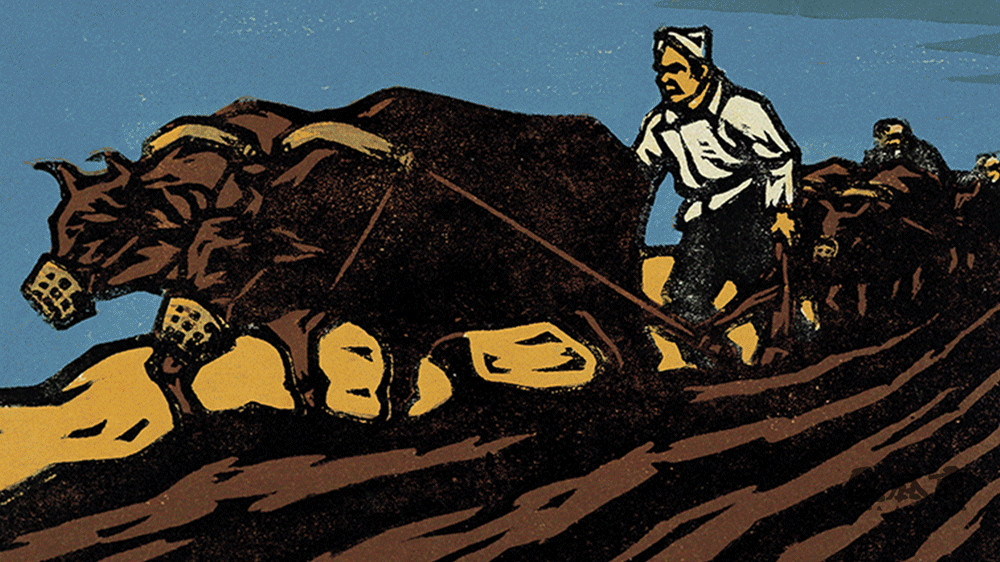
“You should bravely run towards the frontline of times as a flag-bearer, instead of merely holding the tail of the era.”[1]
—A Quote from Diaries of Hu Yichuan, in 1937
As an important artist and art educator of the 20th century in China, Mr. Hu Yichuan’s life and creations are inseparable from the turbulent revolution, growth and history of China in the last century. In 1930, Hu Yichuan participated in the left-wing art group “One Eight Art Society ”(CN.一八艺社), during which he created woodcut works such as “Hungry People”, “Displaced”, “Unemployed Workers” among others. The woodcut work “Going to the Frontline” created in 1932 powerfully depicted the extreme realistic issues at that time, showing the national spirit and vigorous emotions of the working class and revolutionary youths running towards the front with enthusiasm before the Second Sino-Japanese War.
In 1938, Hu Yichuan organized the “Lu Xun College of Art Woodcut Working Group” to carry out anti-Japanese war propaganda at the enemy's rear. Since the founding of the People’s Republic of China, Hu Yichuan’s creations began to turn to oil paintings. With his strong personal characteristics, he completed thematic oil painting creations such as “Breaking out the Chains”, “Digging the Tunnel”, “The Eve”, and “In Prison”. At the same time, Hu Yichuan began to create a series of landscape oil paintings. In these works, we can see the artist go deep into life, nature and the times to sketch. At the technical level, the works still maintain the naive and simple lines, strong and dense colors, and a unique expression featuring solid power. When Mr. Luo Gongliu remembered Hu Yichuan and his paintings, he once commented: “I look at Hu Yichuan’s oil paintings as if I have seen Hu Yichuan himself, seeing his character, personality, quality, talent, cultivation, and aspirations. His style is true and sincere, so it is beautiful." [2] Whether facing artistic creations or several choices in life, Hu Yichuan was always “standing” on the frontline of the times.
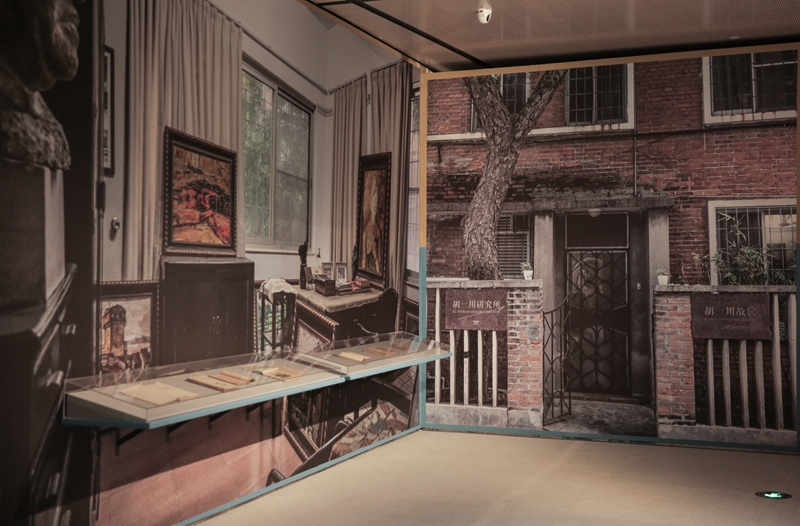
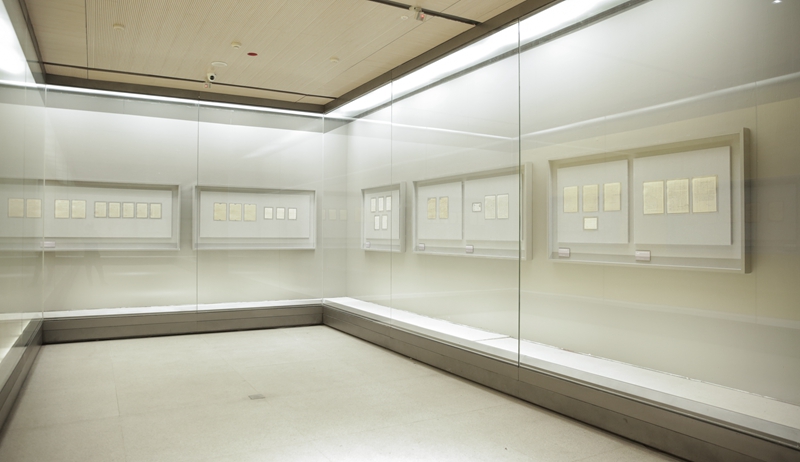
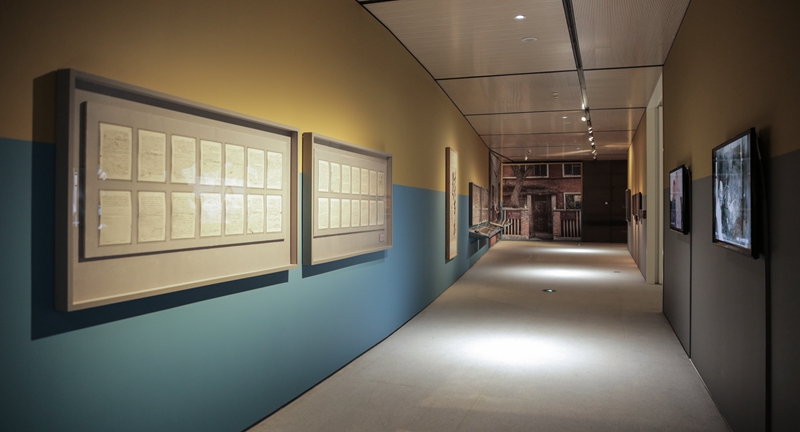
Exhibition View
On the 18th of November, “Standing on the Frontline of Life: Art and Archives of Hu Yichuan” co-organized by Central Academy of Fine Arts and Guangzhou Academy of Fine Arts, has officially launched at CAFA Art Museum. Divided into five parts, it tries to elaborate on Hu's life from his oral history, artworks, archives of his art education and his life choices, showcasing his life pursuit of “running towards the frontline of time as a flag-bearer”. The exhibition will showcase around 500 pieces of artwork and documents that represent Hu’s life. Many archives are shown for the first time.[3]
It should be said that in addition to Hu Yichuan’s rich artistic achievements, the value of his life is also a shining example in art education, work in the Party organization and personal qualities and emotions. Therefore, in the exhibition “Standing on the Frontline of Life”, woodcuts and oil paintings are only part of the exhibit. More space is left for large numbers of diaries, work records and other documents meticulously preserved by Hu. The Intervention of archival materials in this exhibition also invites the audience to stop and read. From behind the strokes of Hu Yichuan’s words, the viewer can perceive Hu Yichuan not only from the perspective of art history research, but also view his complexity as an ordinary “person”, as well as his passion and romance, pain and entanglement in the face of various choices and encounters in life.
Starting from the Structure of the Exhibition:
“Comrade Hu Yichuan”
The exhibition starts with a wall where a video of “Hu Yichuan” from other people’s perspectives was interspersed with old photos. Those faded old photos record important nodes in Hu Yichuan’s turbulent life, almost all were taken with various people at different times, while the video material processed as black and white and silent comes from the interviews with Hu’s friends, colleagues, etc., conducted by Hu’s family members over recent years. In this general introduction chapter, the chronology of his life does not appear on the exhibition wall as auxiliary materials, but a more vivid image narrative method to stereoscopic Hu Yichuan in the “relationship” with different people is conducted.
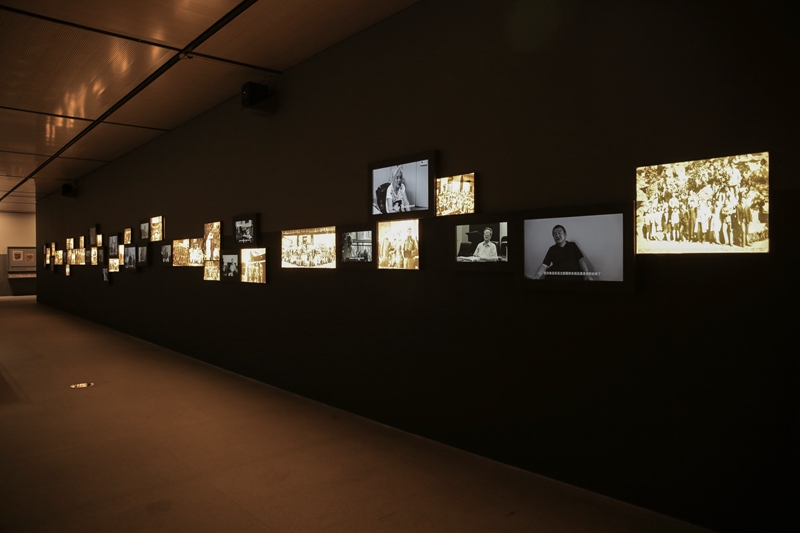
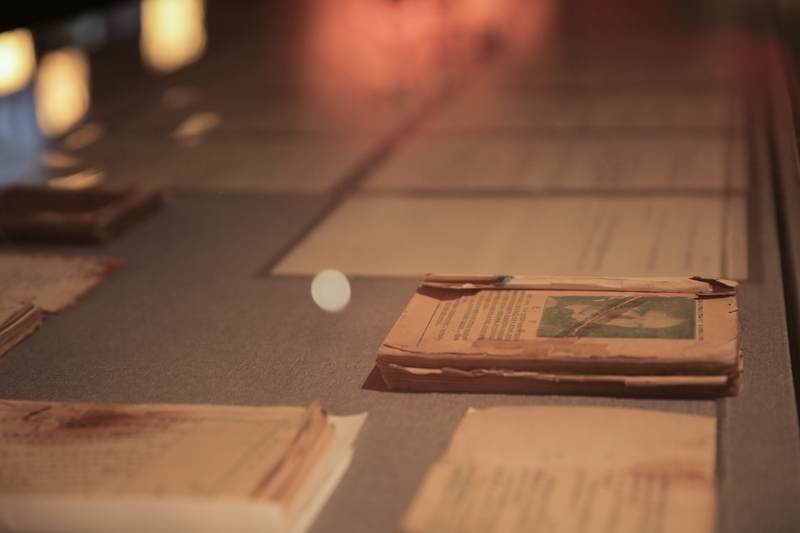
Exhibition View
It is worth noting that in the archive display cabinet in front of the photo-video wall, there is a chronology written by Hu Yichuan. This 13-page handwritten chronology combs and reviews the important time nodes of Hu’s life from the perspective of himself. From a closer look, all the handwriting that has been deleted or added allows the viewer to follow Hu’s memories and records and returns to the vivid memories. A series of Hu Yichuan’s diaries, including small diaries carefully preserved during the war period, is displayed next to the handwritten chronology. In addition, the exhibition also presents the reminiscences of the older generation of artists who have worked with Hu Yichuan, such as Luo Gongliu and Wang Zhanfei, from the perspective of comrades-in-arms, colleagues, and friends. They either retrospected Hu from his general art and life career, or by reviewed the little things in life with Hu. For instance, Wang Zhanfei’s reminiscence text in 2003 described in detail the superb swimming skills and graceful posture of Hu Yichuan, and he ended the text with, “after decades, I have never seen such a good-looking swimming style”. As a result, in the narratives of different forms and different angles, the image of "comrade Hu Yichuan" is gradually vividly presented to the viewers.
By replacing the indispensable chronology in most retrospective exhibitions with the handwritten version, the exhibition introduces Hu Yichuan from a more diverse dimension. The narration of photos, video, and the co-presentation of artworks and selected archives also allow the audience to flexibly receive the information—either as a glance or to intensively read to learn more. Based on the prologue section, the exhibition further expands from three aspects, namely, “Hu Yichuan's Woodcuts and Archives”, “Hu Yichuan’s Oil Paintings and Archives”, and “Hu Yichuan's Aesthetic Education and Archives”, discussing and presenting Hu’s contribution and experience in the aspects of woodcut, oil painting and art education respectively.
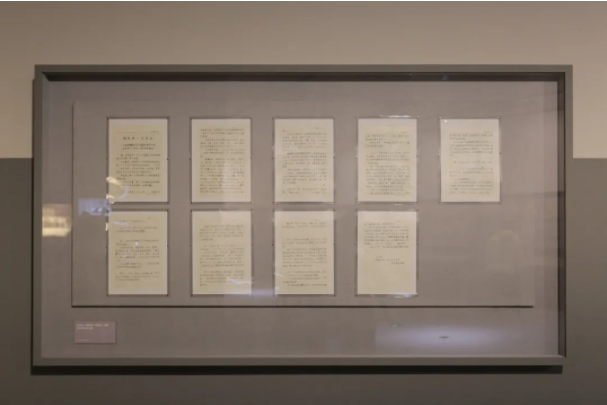
Mr. Wang Zhanfei’s Reminiscence Text in 2003
Until the final chapter “The Aria of Love and Life and Death”, the exhibition once again returned to “Hu Yichuan as a person”, stripped of his various social status and identities, and presented his concept and understanding of family, loves, life and death from a more private perspective.
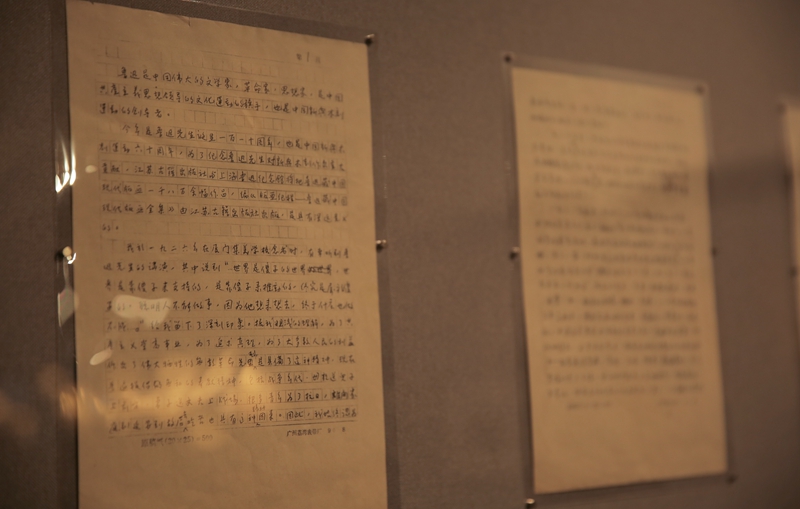
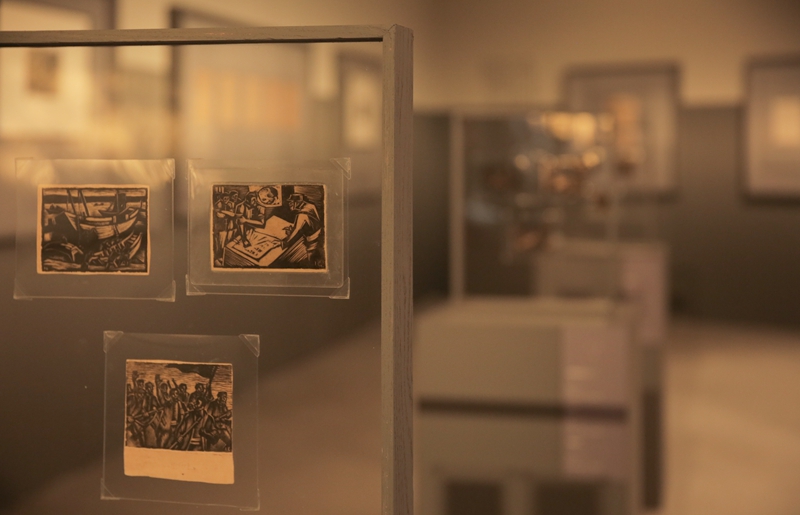
Exhibition View
Creations and Diaries:
“Standing on the Frontline of Life”
When offering a retrospection of Hu Yichuan’s artistic career featuring woodcuts and oil paintings, it can be roughly divided into the following stages. From 1930 to 1949, Hu Yichuan was in Hangzhou, Shanghai, Xiamen, and then moved to Yan'an. During this period, he focused on woodcut creations and during his time in Yan'an, he served for the art organization and propaganda work. After the founding of People’s Republic of China in 1949, Hu Yichuan’s artistic career entered the oil painting period, during which he created a large number of themed historical oil paintings as well as landscape oil paintings, and the preparation and organization of domestic professional art academies were also carried out at this stage. In his later years, Hu Yichuan’s creation focused on landscape oil painting. [4] The characteristics of naive, heavy, and full of power in his work are a consistent style and logic of Hu Yichuan's creation from woodcut to oil painting.
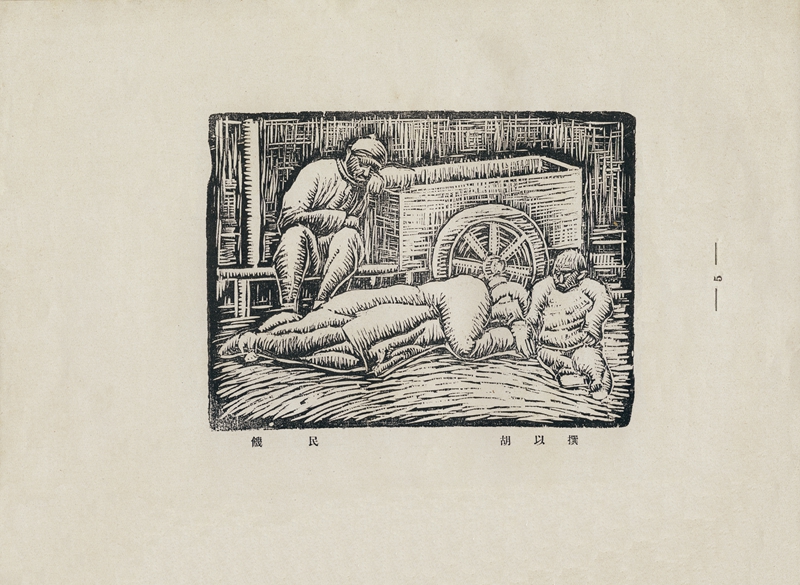
"Hungry People", Hangzhou,Monochrome Woodcut, Unknown Size, 1930Published on The Catalogue of the Study Exhibition of "One Eight Art Society" in 1931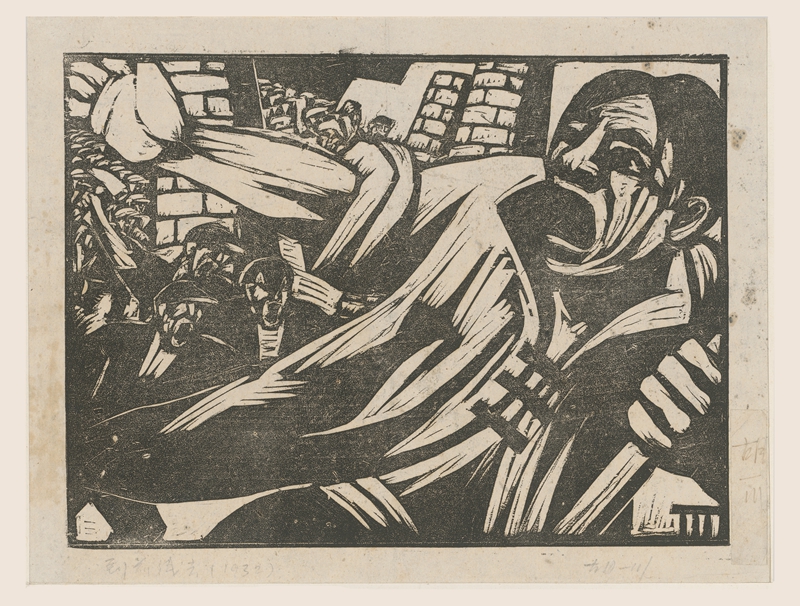
"Going to the Frontline", Shanghai, Monochrome Woodcut, 25 x 33cm, 1932
Collection of National Art Museum of China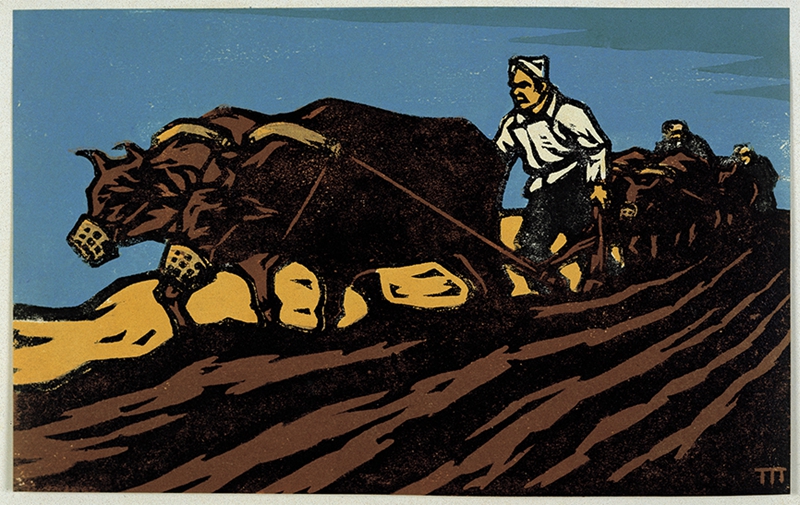
"Farm Labor-exchange Teams", Yan'an, Color-matching Woodcut, 11.7 x 19cm, 1943
Collection of Hu Yichuan Research Institute of Guangzhou Academy of Fine Arts
For Hu Yichuan, the woodcut creation period is undoubtedly an extremely important part of his entire life experience and artistic career. The earliest woodcut that can be seen so far is “Hungry People” in 1930, which was created when he was studying at Hangzhou Art College and participated in the “One Eight Art Society ”. It was also at this stage that Hu Yichuan accepted Lu Xun's artistic ideas and came into contact with a series of published woodcut creations. The people in the picture who are hungry either collapse or lean without a clear face. It does not specifically refer to a crowd people, but seems to reveal a widespread social phenomenon. At almost the same time, works such as the “Displaced” (1931), “Unemployed Workers”(1931), etc., all intuitively expressed social injustice and civil suffering and other issues.
As Professor Cao Qinghui said, “A group of young people like Hu Yichuan who has embarked on the revolution have expressed much stronger aspirations than they have obtained. They have not experienced too much, but they expressed particularly strong wishes.” Based on such a strong desire to express, after contacting Lu Xun’s artistic ideas and publishing woodcut creations, Hu Yichuan and others were vaguely aware of the powerful expression of woodcutting in the social conditions and context at the time. With the advantage of being convenient for mass publication, “the special feelings for Lu Xun, the ‘superior conditions’ for engraving, and the ‘powerful weapons’ needed by the revolution became the reasons why Hu Yichuan took up the carving knife.”[5]
In “Going to the Frontline” created in 1932, the rugged and powerful carving lines as well as tough and powerful blocks under the knife, vividly portrayed the revolutionary slogan of “Going to the Frontline” that prevailed at that time. By doing so, it depicted a powerful force and national spirit before the War. In 1943, Hu Yichuan created the chromatic woodcut “Farm Labor-exchange Teams” in Yan’an. The colors in the picture are clear and tidy, which makes a strong impact. This grasp and use of lines and colors are also reflected in Hu’s oil paintings over the following years.
In fact, even though Hu has led the “Woodcut Working Group” to go deep behind the enemy and created a series of woodcut works that had significant influence and were appreciated by the masses and leaders, Hu Yichuan's work style was still quite controversial at that time, and was considered to be “partial to formalism”, and a too “expressive style” [6], etc. Hu Shanni, Hu Yichuan’s daughter once recalled, “Many of his works were not understood by people in Yan'an at that time, as they were unlike other people's (works) that were very delicate and exquisite. But he did not care, he has his own personality. I think he thinks about the times, art, and expressing the existence of art from what he understands.”[7]
From the diary of Hu Yichuan in the Yan'an period, it can be seen more intuitively that he has been thinking about many issues such as the way of expression of art, the acceptance of the masses, the balance and grasp of artistic creation and propaganda work— “Explicit propaganda is not art.” “The authenticity of art should be higher than reality.” “A successful woodcut painting is by no means an ordinary photo.” “The method of taking pictures can neither express my inner love for the new society and new things nor express my hatred of the old society and enemies. You must not judge all works by the standard of photography.”[8]
Amid many doubts, we can see from these words that Hu Yichuan has been confused, struggling, swaying and painful in his thinking along the way, but he finally insisted on his pursuit of free expression and spiritual liberation in artistic creation.
After the founding of the People's Republic of China, Hu Yichuan turned to oil painting. He successively created thematic oil paintings such as “Breaking out the Chains”(1950), “The Eve” (1961), “Digging the Tunnel” (1974) and “On the Eve of the Turning Point” (1977). These themes span a long time and are intertwining and fusion of Hu’s life encounters, which makes his artistic techniques increasingly mature in addition to sticking to the affirmative expression of self-characteristics. Whether it is the tense atmosphere in the tight space in “The Eve”, the praise of revolution and the overflowing yearning for the freedom of the future in “Breaking out the Chains”, or the bright blue sky outside the window of “In Prison” (1981), the presentation of these thematic creations, on the one hand, traces back the revolutionary years of a generation of people fighting for freedom. On the other hand, the past experiences and emotions of imprisonment, life and death, and war are all endowed by Hu Yichuan in the artistic expression of these pictures. This may be exactly what he is pursuing for “the authenticity of art that should be higher than reality”.
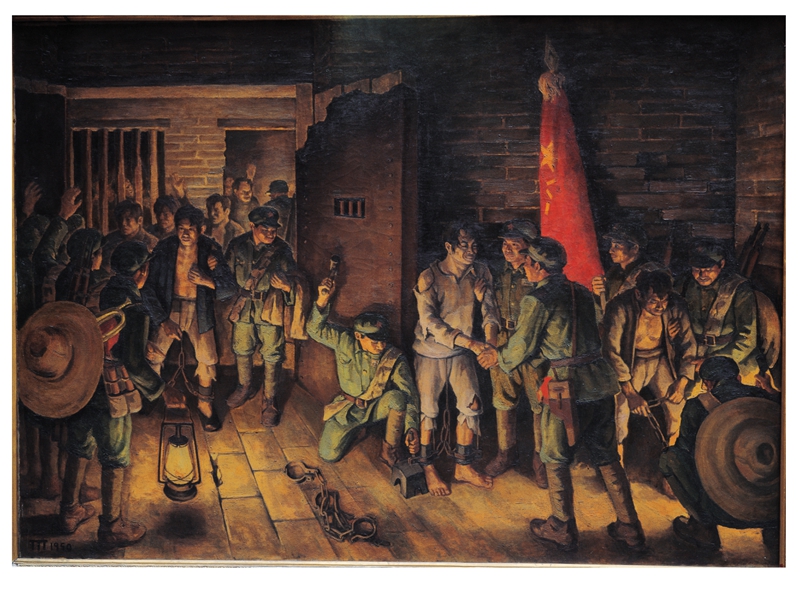
"Breaking of the Chains", Beijing, Oil on canvs, 174 x 244cm, 1950
Collection of the National Museum of China
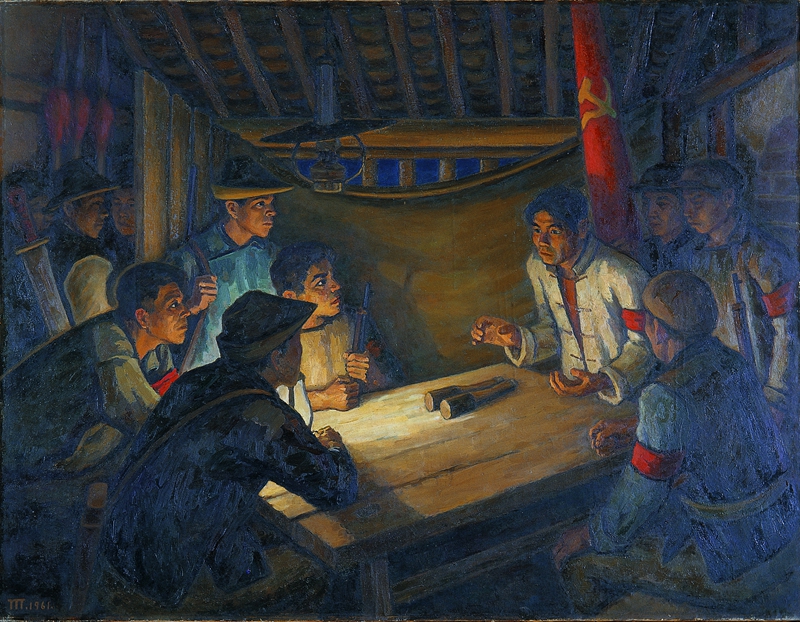
"The Eve", Guangzhou, Oil on canvas, 140 x 181.5cm, 1961
Collection of the National Art Museum of China
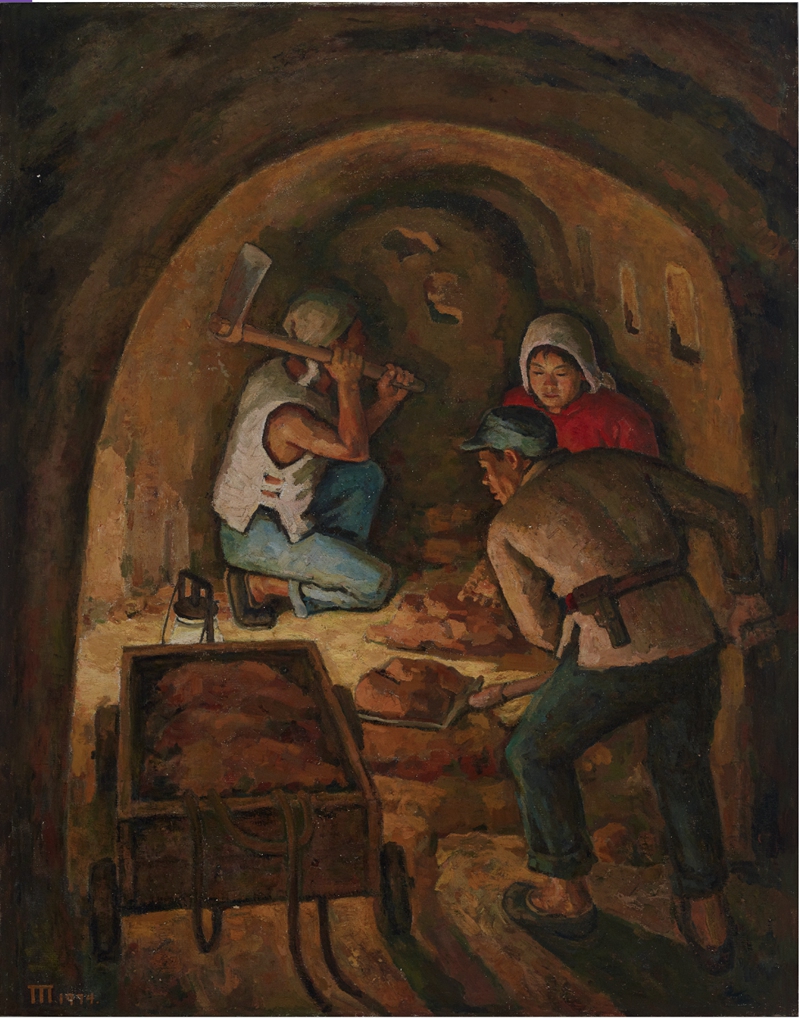
"Digging the Tunnel", Hu Yichuan, Guangzhou, Oil on Canvas, 146 x 112cm, 1974
Collection of Art Museum of Guangzhou Academy of Fine Arts
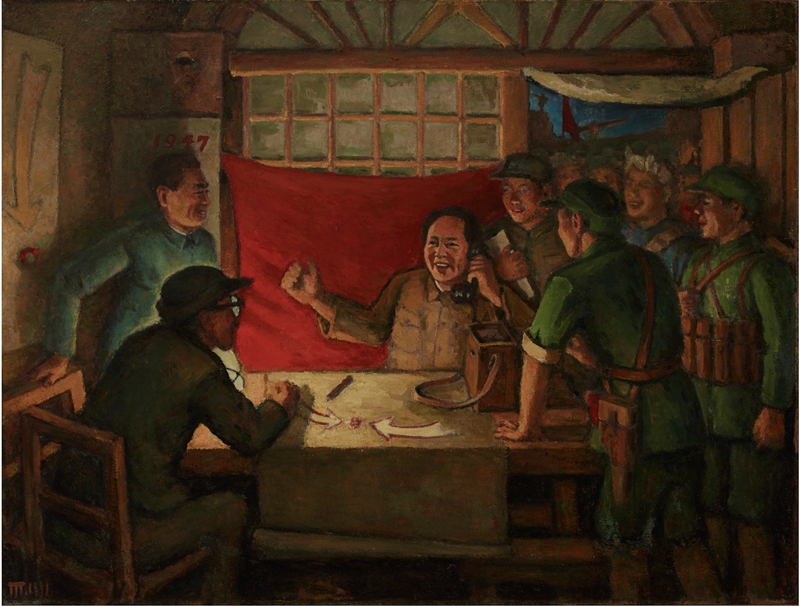
"On the Eve of the Turning Point", Guangzhou, Oil on Canvas, 131 x 170cm, 1977
Collection of Hu Yichuan Research Institute of Guangzhou Academy of Fine Arts
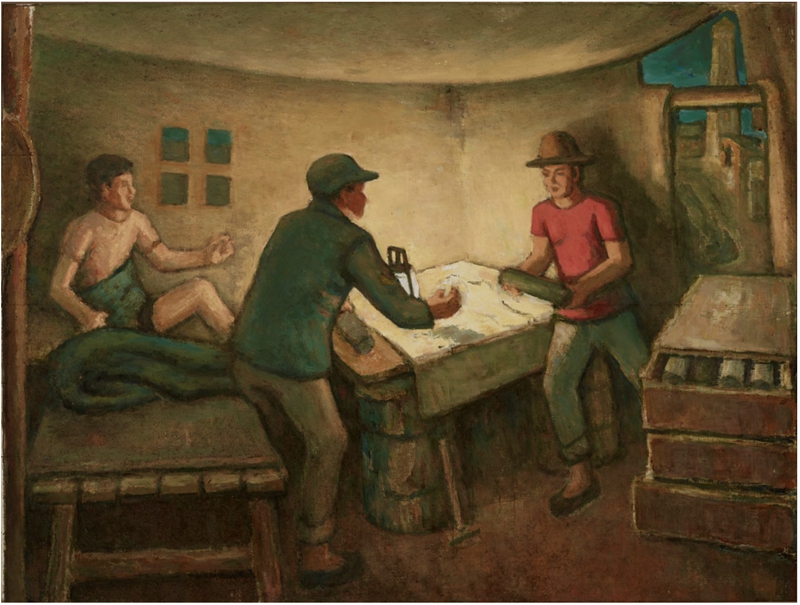
"Discovering Mine", Guangzhou, Oil on Canvas, 140 x 186cm, 1994
Collection of Hu Yichuan Research Institute of Guangzhou Academy of Fine Arts
Choice, Contradiction and Emotion:
“It should be tenacious in the deep heart.”
For Hu Yichuan, the doubts and contradictions encountered in the creation process are only one aspect.
In the corner of the exhibition hall, the creation process of Hu Yichuan's “Crossing the Snow Mountain” is presented, including a series of sketches obtained from a field trip to Mount Erlang. “The cold wind blows from the north to the south, and the Red Army must move stubbornly to the north. This sharp struggle can unify my picture.” [9] In Hu Yichuan's diary, he faithfully recorded what he had in his mind when he climbed the snow mountain. This in-depth experience of collecting materials was full of Hu’s creative enthusiasm. However, because of the “rectification movement”, Hu Yichuan, who was the principal and party secretary of the Zhongnan Institute of Art, had to temporarily shelve the creation of this painting, and invested energy and time to the administrative tasks. For this reason, he was anxious, painful and helpless. What was even more regrettable was that the final work completed a few years later has not been published in any publications, and the complete concept and mood presented in Hu Yichuan’s diary have become the most direct material when reviewing this creation.
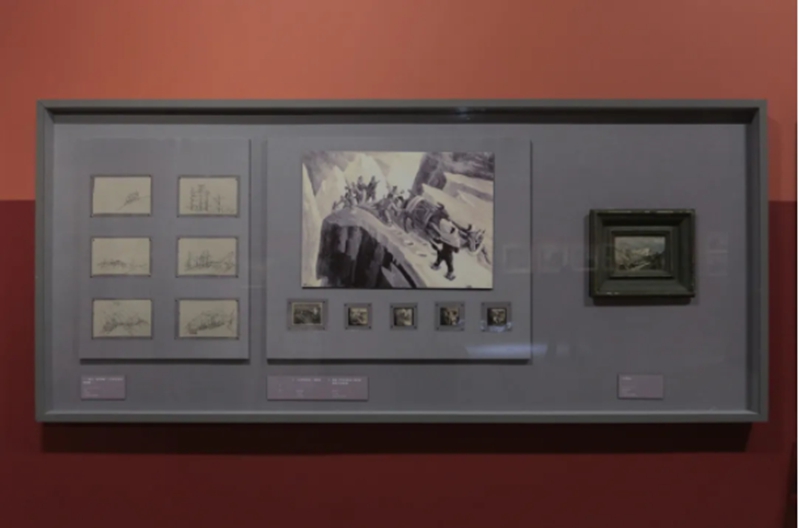
Exhibition View of "Crossing the Snow Mountain"
“I want to go down to (the Tunnel) right away, I want to start painting right away, but there are so many administrative tasks that I can't go away for a while. If this year I can have more time to draw a painting on the subject of drilling the Tunnel, it would be exciting.”[10] The lack of creative time caused by the development and execution of political and organizational work seems to have been one of the most contradictory and tangled areas in Hu’s creative process. Even so, whether it is a woodcut, a realistic or landscape-themed oil painting creation, he is always on the path of artistic expression that he pursues. Meanwhile, in regards heavy administrative tasks—from co-founding the Central Academy of Fine Arts, to being appointed to establish the Zhongnan Institute of Art, and then moving to Guangzhou and renaming the institute as “Guangzhou Academy of Fine Arts”, he never slackened. Professor Cao Qinghui, the curator of this exhibition, explained the title of the exhibition “Standing on the Frontline of life” that, “‘Standing’ is an action that sometimes proactively takes and sometimes passively is accepted. Hu Yichuan's particularity is also reflected in his conscientiousness in any position in his life. The word “consciousness” can be understood in a rich way. A person's consciousness is embodied in that he or she must consciously move forward with the times while consciously obeying the requirements of the party organization.” [11]
If we read Hu Yichuan's writings in different periods in detail, we could often see expressions such as “You should...” and “You should not...” in a large number of diaries. It seems that Hu Yichuan in reality is talking to Hu Yichuan in his mind:
“You should concentrate your thoughts and emotions on the idea of this historical painting as soon as possible.”
“You should clearly understand in your mind that there are limited scenes in the universe that can be painted, and there are too many scenes that can be seen but are not able to be drawn.”
...
These sentences reveal that Hu Yichuan has an extremely strict and clear pursuit of his art and work. He constantly encourages himself through continuous writings. He summarized the shortcomings in his work and creation, and put forward new possibilities and hopes. Meanwhile, he also expressed his worries and entanglements in his diaries and letters from time to time. It seems that through such continuous self-talk and suggestions, he has transformed the pressure and burdens, contradictions and entanglements that he bore into the driving force for continuous progress. At the same time, the deep emotion between Hu and his wife Huang Junshan has also become his motivation to urge him to keep creating. “Double harvest in health and career” is the blessing and expectation of his wife Huang Junshan to him during her lifetime.
The video at the end of the exhibition shows the two letters Huang Junshan wrote to Hu Yichuan during the years of war, which depict Huang’s faithfulness and sincerity. It is this steadfast and persistent emotion that Huang Junshan traveled all the way from Myanmar to Yan'an, and finally met with Hu Yichuan to then spend their life together. In 2000, following the will of Hu Yichuan and Huang Junshan, their children sprinkled their ashes into the sea.
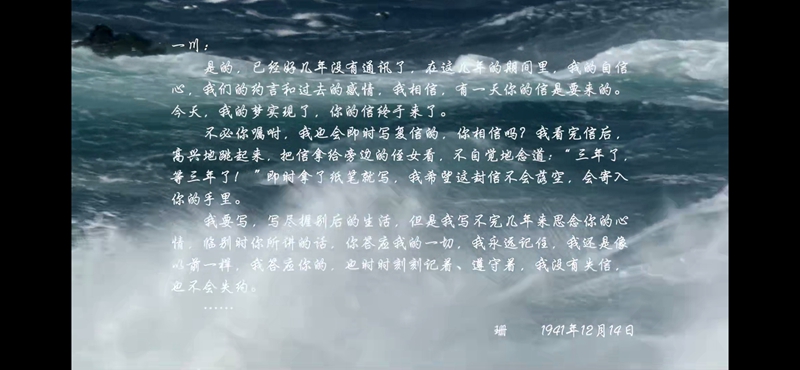

Screenshot of Video Featuring Letters between Hu Yichuan and Huang Junshan ©CAFA ART INFO
In 1939, Hu Yichuan wrote in his diary, “It should be tenacious within the deep heart.” Pan Xingjian used this sentence to end his study “Discussing Hu Yichuan’s Printmaking Art”. He believes that the interpretation of Hu Yichuan's art and life in the 1930s and 1940s could be summarized as “the awakening of a tenacious subject”. [13] And this stubborn tenacity actually permeates every stage of Hu Yichuan's life and creation, and integrates with his creation, experience and emotions. With this inherent stubbornness and tenacity, he bravely stood at the forefront of creation, life and the times, to persevere and also to open up.
By reviewing the exhibition, the intervention of archives allows the audience to selectively understand Hu Yichuan from more diverse perspectives and dimensions, apart from the works of art. When reading these words preserved in the war-torn era, the exhibition actually attempts to provide a space for dialogue. When digital media and images are saturated and flooded with all aspects of life today, when we once again revisit the era of printed media reading, we may be able to find some more sincere touches from it.
Text by Emily Weimeng Zhou
Edited by Sue/CAFA ART INFO
View of Exhibition by Hu Sichen
Artworks and Archival Materials Courtesy of the Organizers.
References:
[1] Cited from Hu Yichuan’s Diaries, in 1937.
[2] Luo Gongliu, Quoted from Preface to Hu Yichuan Oil Painting Collection, P5, 1999.
[3] Exhibition Text of “Standing on the Frontline of Life: Art and Archives of Hu Yichuan”, 2020.
[4] Pan Xingjian, “Discussing Hu Yichuan's Printmaking Art: From the Subjectivity of Chinese New Woodcut Artists”, Hu Yichuan's Printmaking and Sketch Collection, P8, 2000.
[5] Ibid.
[6] Hu Yichuan’s Diaries, Quoted from Wang Huangsheng, “Reading Hu Yichuan’s Diaries, Oil Paintings and Life”, published in Hu Yichuan Oil Painting Collection, P8, 2003.
[7] The documentary of “Standing on the Frontline of Life: Art and Archives of Hu Yichuan”, CAFA Art Museum.
[8] Cited from Hu Yichuan’s Diaries during His Stay in Yan’an.
[9] Hu Yichuan, “Artistic Thinking—About ‘Crossing the Snow Mountain’”, Hu Yichuan Oil Painting Collection, P20.
[10] Hu Yichuan, “Artistic Thinking— in the 1950s”, Hu Yichuan Oil Painting Collection, P44.
[11] A Conversation between Professor Cao Qinghui, the curator of this exhibition, and CAFA ART INFO.
[12] Cited from Hu Yichuan’s Diaries.
[13] Pan Xingjian, “Discussing Hu Yichuan's Printmaking Art: From the Subjectivity of Chinese New Woodcut Artists”, Hu Yichuan's Printmaking and Sketch Collection, P8, 2000.
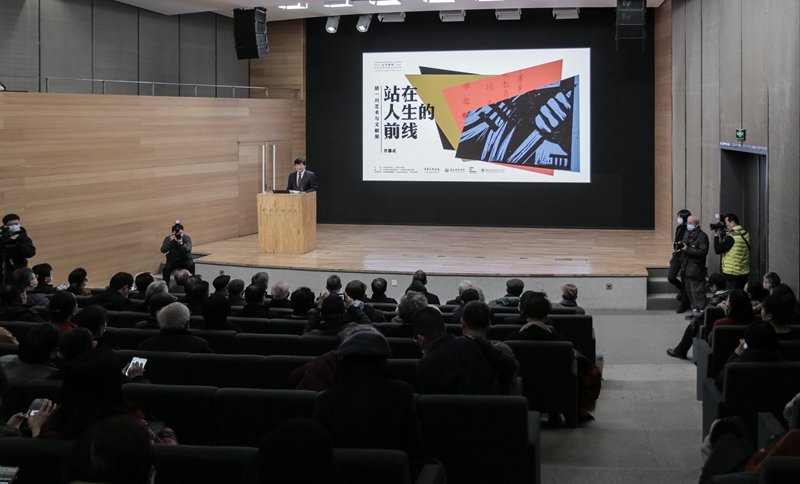
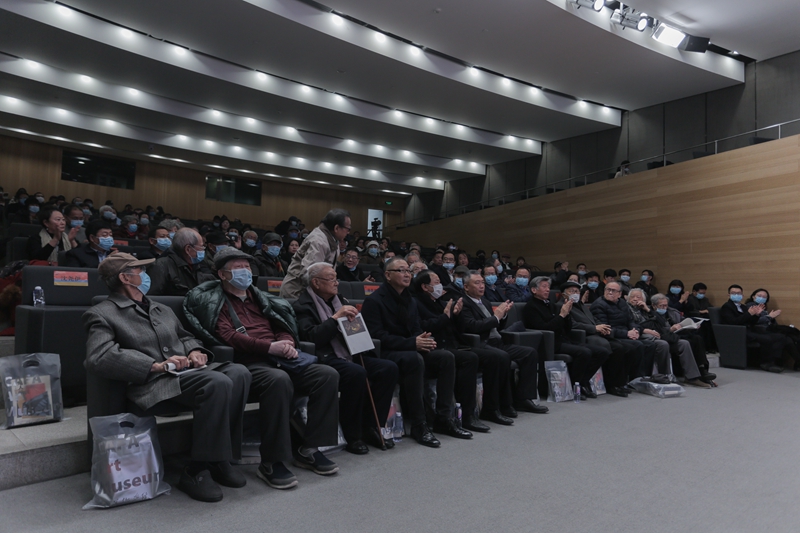
View of the Opening Ceremony
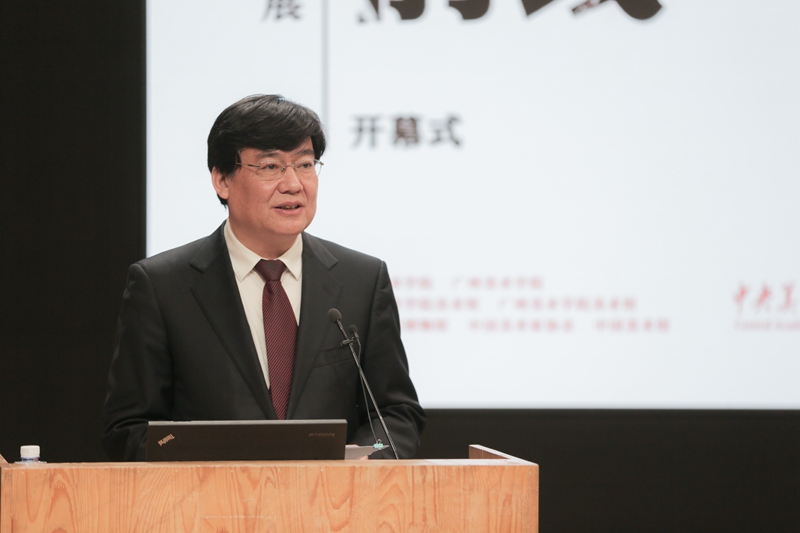
Gao Hong, Party Secretary of CAFA, hosted the Opening Ceremony.
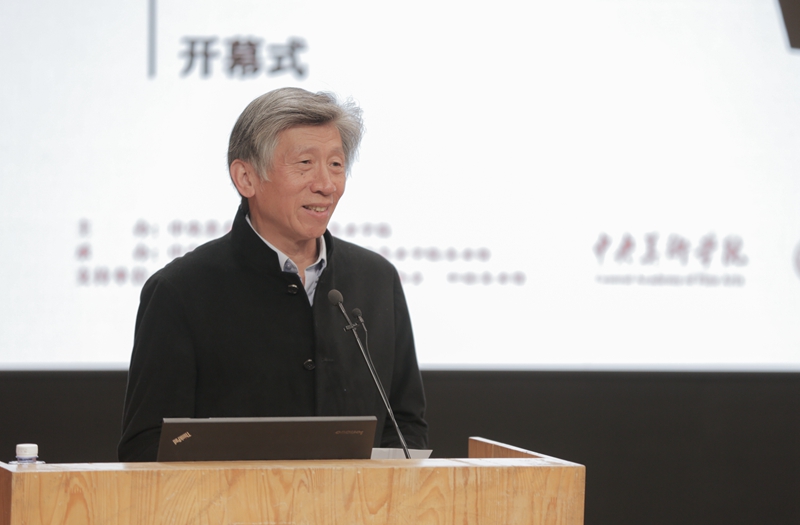
Fan Di’an, Chairman of the China Artists Association and President of CAFA, delivered a speech at the Opening Ceremony.
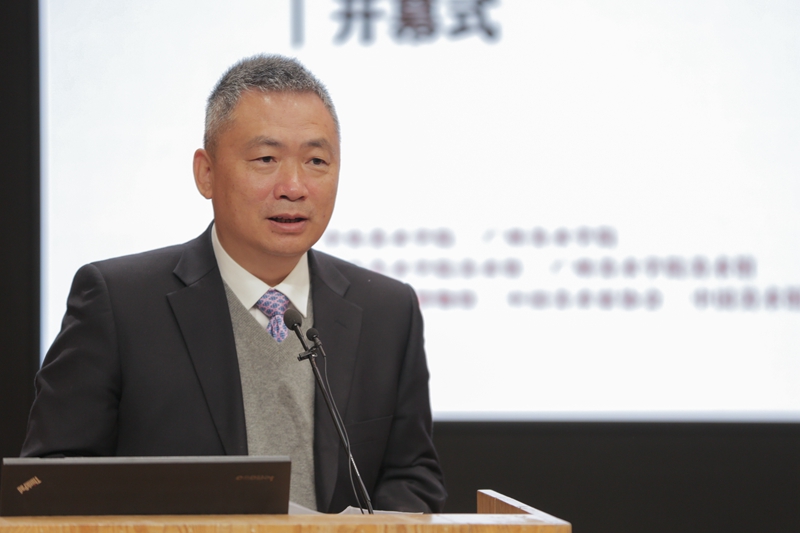
Xie Changjing, Party Secretary of Guangzhou Academy of Fine Arts, delivered a speech at the Opening Ceremony.
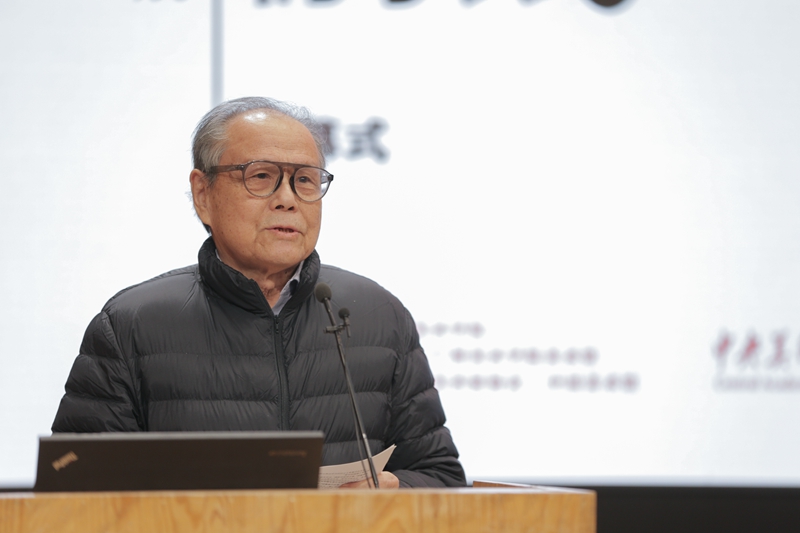
Professor Du Jian, the student representative of CAFA in the early days of its establishment, the former deputy Party Secretary, delivered a speech at the Opening Ceremony.
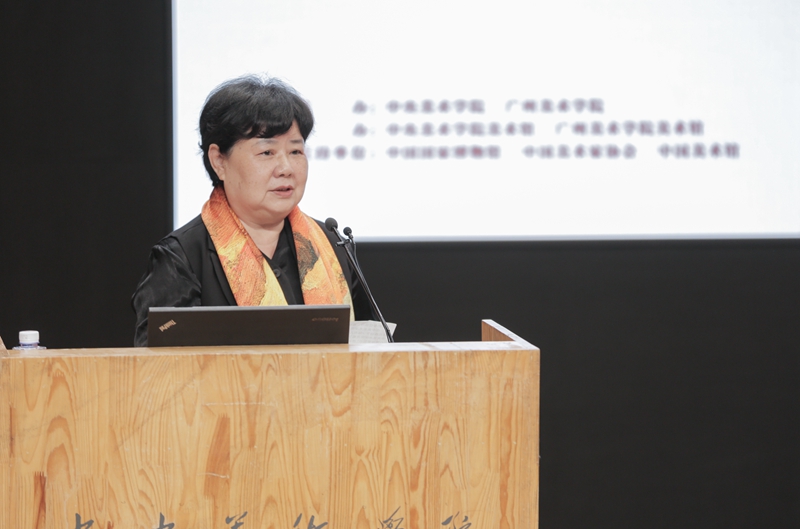
Family member representative, Ms. Hu Chuanni, daughter of Mr. Hu Yichuan, delivered a speech at the Opening Ceremony.
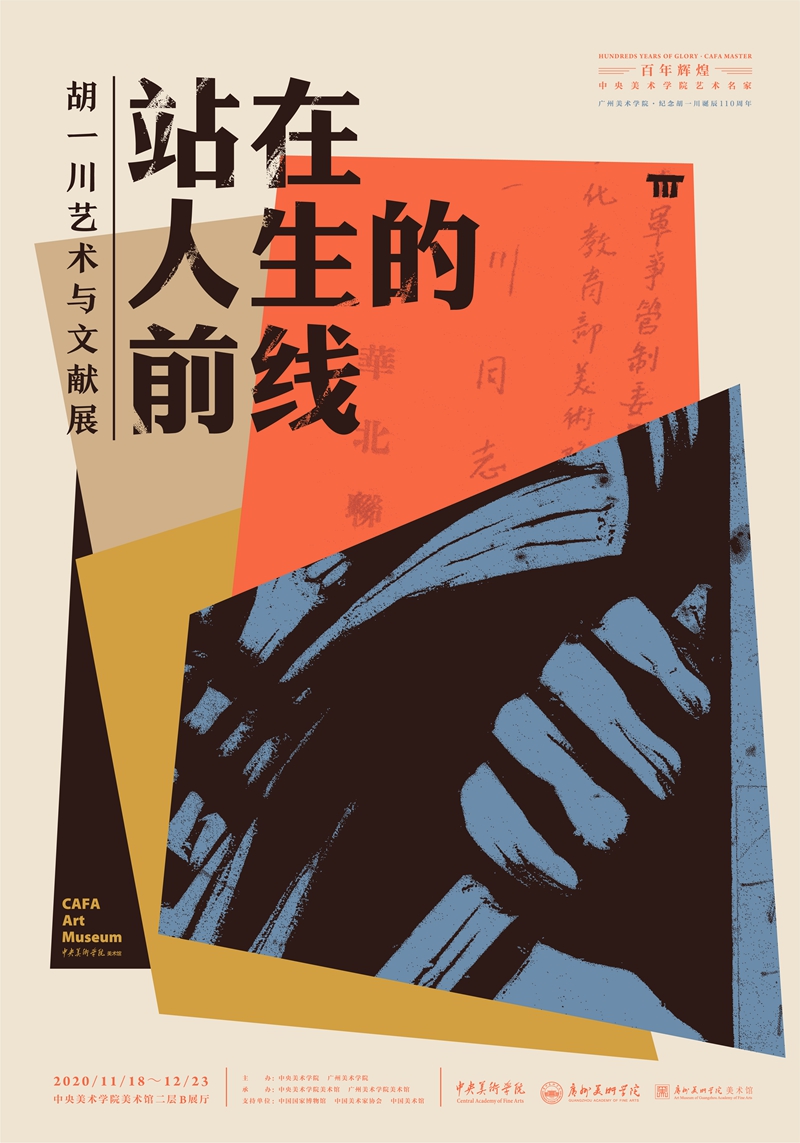
Hundred Years of Glory · CAFA Masters
Guangzhou Academy of Fine Arts · Commemorating Hu Yichuan's 110th Birthday
Standing on the Frontline of Life:
Art and Archives of Hu Yichuan
Organizers: Central Academy of Fine Arts, Guangzhou Academy of Fine Arts
Undertakers: CAFA Art Museum, Art Museum of Guangzhou Academy of Fine Arts
Supporters: National Museum of China, China Artists Association, National Art Museum of China
Duration: 2020.11.18 - 12.23
Venue: CAFAM Gallery 2B




























